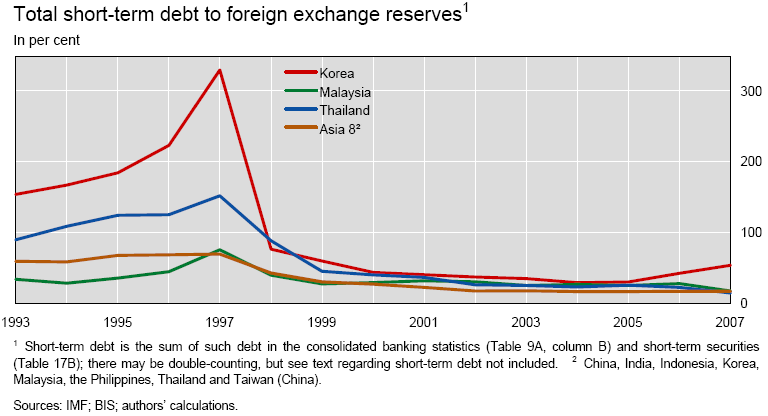The Asian financial crisis: international liquidity lessons
(Extract from pages 76-77 of BIS Quarterly Review, June 2008)
While the debate continues over the role played by such underlying factors as excessive investment, currency appreciation, overleveraging of banks and firms, and corporate governance in the Asian financial crisis (eg Ito et al (2007)),1 the importance of international liquidity management commands wide agreement. Economies with stronger international liquidity weathered the risk reassessments, while those with weaker positions suffered an international run. Since short-term international interbank borrowing often represents the bulk of a country's short-term foreign debt, lessons drawn regarding national liquidity relate closely to the position of banks in the international interbank market.
An often cited measure of international liquidity shows a very different position today than in 1997-98 for Asian economies. Consider international short-term debt, defined as international claims of BIS reporting banks with a maturity of one year or less (on not only banks, but also firms and governments) plus international debt securities with a remaining maturity of one year or less in relation to foreign exchange reserves. (There can be double-counting in this measure to the extent that BIS reporting banks hold the short-term and maturing securities.) For an average of eight Asian countries, namely China, India, Indonesia, Korea, Malaysia, the Philippines, Taiwan (China) and Thailand, short-term debt was climbing more rapidly than reserves before the 1997 crisis (see graph). In Indonesia, Korea and the Philippines, foreign exchange reserves eventually covered less than half of overall foreign short-term debt. Since the end of 1998, this coverage has diametrically changed. As current accounts have swung into surplus and foreign exchange reserves have climbed, short-term debt has fallen well below official reserves.
This measure, however, is subject to two important qualifications. First, it does not capture the short-term debt that overseas affiliates of domestic banks and firms have contracted offshore. At a certain point in the Korean crisis, the revelation of a very substantial sum in offshore borrowing by Korean banks and chaebol outside Korea shook sentiment as market participants understood that this borrowing also represented a claim on Korean reserves and borrowing capacity (Blustein (2001)). Such data, even when collected by the authorities, are rarely published, with the result that the relevant short-term debt is usually understated.
BIS consolidated banking data can be used to obtain a partial measure of offshore loans that are guaranteed by residents of a given country. So-called inward risk transfers capture, inter alia, global banks' claims on the branches of a given country's banks that are located in London or New York. While these data do not come with a maturity breakdown, the amounts involved provide some indication of short-term debts contracted offshore by offshore affiliates. In the cases of Korea, the Philippines and Thailand, inward risk transfers are less than 10% of short-term debt on an immediate borrower basis. Only in the case of Malaysia do inward risk transfers (at $6 billion) represent a substantial fraction (28%) of short-term debt on an immediate borrower basis ($21 billion).
Second, and more fundamentally, juxtaposing international reserves of the official sector and the short-term debt largely contracted by the private sector ignores all the issues that arise when the official sector has to provide liquidity to the private sector (Hawkins and Turner (2000)). While the existence of large official reserves doubtless makes less likely a run on private banks perceived to be benefiting from an umbrella, the first line of defence of a nation's banks against international illiquidity is, and should be, their own asset-liability management (BCBS (2008)).
1 The pervasiveness of an aggregate currency mismatch has been questioned (Cho and McCauley (2003)).

